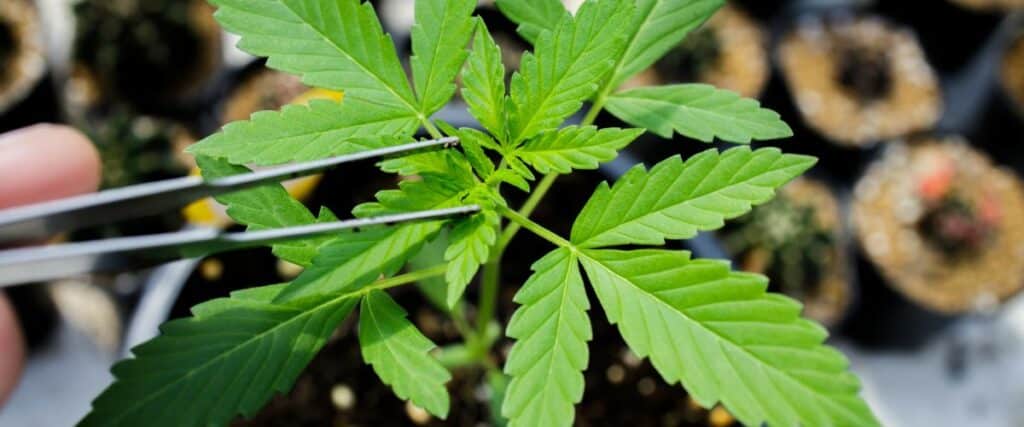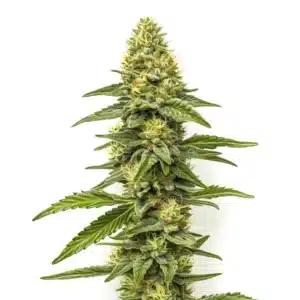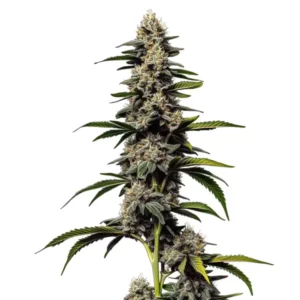Achieving optimal lighting conditions for cannabis seedlings is paramount. The Photosynthetic Photon Flux Density (PPFD) is pivotal during this crucial growth phase. But what constitutes the ideal PPFD for cannabis seedlings?
Today, we’ll delve into the fundamentals of PPFD, shedding light on its profound impact on the development of young cannabis plants. Whether you’re a novice cultivator or a seasoned expert, grasping the appropriate PPFD levels can significantly enhance the vitality and productivity of your plants.
Join us as we uncover the optimal PPFD for seedlings, ensuring you’re equipped to provide your plants with an auspicious beginning.
What is PPFD?
Grasping key terms like PPFD, which stands for Photosynthetic Photon Flux Density, is essential for optimizing your grow setup. PPFD quantifies the photons of light reaching your plant’s surface per second. This metric is pivotal as it directly influences your plants’ photosynthetic processes, essential for their growth and energy conversion. Understanding the best PPFD for seedlings can help you provide just the right amount of light intensity during the early stages, promoting healthy and vigorous development.

Promos & Deals
Maximizing Cannabis Growth: Importance of PPFD Levels
During the initial growth phase, young plants are highly sensitive to their surroundings. Inadequate light impedes their energy production for robust root and leaf development, while excessive light can induce stress or harm. Additionally, improper light distance causes stretching, resulting in frail and unstable plants that struggle to regain vigor. Prolonged exposure to suboptimal light levels further diminishes both the quality and quantity of yield. Thus, understanding the ideal PPFD for cannabis seedlings is crucial for ensuring optimal and rapid growth during this vulnerable stage.
Optimal PPFD Levels for Every Growth Stage
The various growth phases plays a pivotal role in optimizing factors such as PPFD. These phases encompass the seedling, vegetative, and flowering stages, each demanding specific light conditions.
During the seedling phase, cannabis plants embark on their initial growth journey. As they emerge from the seed, they start to form their primary leaves. It’s crucial not to subject seedlings to excessive light levels during this fragile stage.
Applying the appropriate PPFD during this phase fosters robust root development and vigorous foliage growth, laying a sturdy groundwork for subsequent stages.
As plants progress into the vegetative phase, they necessitate heightened light intensity to fuel their rapid growth and leaf expansion. This phase primes the plants for flowering, during which light requirements will evolve again to facilitate optimal bud production.
Optimizing Cannabis Growth: Achieving the Perfect PPFD Levels for Your Cannabis Seedling
It’s important to ensure that cannabis seedlings receive the ideal PPFD for seedlings, typically falling between 100 to 300 μmol/m²/s. This range of PPFD for autoflowers and other cannabis varieties provides sufficient light energy to support initial growth without overwhelming the young plants.
When PPFD levels dip below 100 μmol/m²/s, seedlings may suffer from insufficient light, resulting in sluggish growth and weakened development. Conversely, surpassing 300 μmol/m²/s can induce light stress, potentially hindering growth or causing damage to delicate seedlings.
During the early stages, seedlings rely on stored energy from the seed until their leaves can undertake photosynthesis. They thrive in a gentle environment with moderate PPFD levels (100-300 μmol/m²/s), promoting stress-free growth and fostering robust root and foliage development.
Achieving the right balance in seedling PPFD is crucial during this phase, particularly for cultivating vigorous, healthy seedlings primed for the vegetative stage. Consistency is key, with stable conditions encompassing light, humidity, and temperature, often maintained under an 18-hour light schedule (or more) with 6 hours off.
By adjusting grow lights to uphold PPFD within this optimal range, significant improvements can be seen in seedling health. Adequate PPFD levels support the cultivation of a robust root system, sturdy stem growth, and the emergence of the first true leaves, all vital for overall plant vitality.
The perfect PPFD for cannabis clone
On the flip side, clones originate from mature plants via cuttings, starting with a more advanced structure and pre-formed leaves. They bypass germination but must establish roots from the cutting site, a crucial phase. Clones typically demand a similar environment and nutrition as the original plant to root effectively. However, reducing PPFD for cannabis seedlings (to around 100 μmol/m²/s) in the initial 3 to 5 days can alleviate stress and promote healthy root development.
Light intensity for clones should be lower to prevent dehydration and stress, considering their underdeveloped root system, which hinders efficient water uptake. Both seedlings and clones flourish in high-humidity settings, minimizing water loss through transpiration. Nonetheless, clones may require higher humidity and a lower VPD environment initially due to their root deficiency. Adjusting light intensity, humidity, and temperature appropriately is crucial for the successful cultivation of both seedlings and clones.

The relation between light distance and PPFD
The elevation of grow lights holds significant importance in determining the PPFD (Photosynthetic Photon Flux Density) reaching your cannabis plants. Placing grow lights in closer proximity to the plants increases the PPFD, facilitating more available light photons for photosynthesis.
However, excessive proximity can result in light burn, causing damage to plant tissues, particularly the leaves. Conversely, elevating the position of the grow lights decreases the PPFD as the light disperses and becomes less intense over a broader area.
Nevertheless, if the lights are positioned too high, the light received by your plants might be insufficient, leading to stretching as they strive towards the light source, resulting in weak and elongated stems. Knowing PPFD for cannabis seedlings is essential during early growth stages, as inadequate light intensity can hinder healthy development. Hence, achieving the optimal height for your grow lights is a nuanced task, necessitating regular adjustments based on your plants’ growth stage and their responsiveness to light intensity.
The Control Of Stretching In Cannabis Seedling
Adjusting light intensity and proximity is crucial for optimizing plant growth, especially during various growth stages. While general advice suggests maintaining lower PPFD levels by raising lights for clones and seedlings, it’s also noted that vegetative and flowering phases thrive with higher PPFD levels and closer light proximity.
However, each strain or phenotype may respond differently. Some may benefit from starting with LED lights hung closely to prevent stretching. For those with adjustable lights, reducing PPF while keeping lights close is an option, requiring precise monitoring with sensors.
Alternatively, if lights lack brightness adjustment, keeping them at full power but hung farther away is viable, albeit with the risk of stretching in the seedling stage. Regular PPFD measurements with a PAR meter at canopy level aid in making necessary adjustments for optimal growth conditions.
Close attention is essential when hanging lights closer during the seedling stage to avoid high leaf surface temperatures and monitor humidity levels, especially crucial as seedlings require higher humidity.
Continuous monitoring and adjustment as plants grow are necessary to prevent stress. Starting with manufacturer-recommended light heights and adapting based on plant response and signs of stress or insufficient light exposure is recommended for practical application.
Maximizing Plant Growth: How to Optimize PPFD Levels for Enhanced Efficiency and Yield
Once you’ve assessed the PPFD for cannabis seedlings in your cultivation area, the subsequent step involves refining your setup to ensure optimal light conditions for healthy early growth.
Here’s how you can efficiently adjust PPFD levels:
- Modify light positioning: Adjusting the distance between your grow lights and the plant canopy can either enhance or diminish PPFD. Lowering the lights heightens PPFD, whereas elevating them reduces it. However, take caution regarding heat emission to prevent plant overheating.
- Adjust light intensity: Certain grow lights feature adjustable intensity settings, allowing you to fine-tune PPFD levels without relocating the lights.
- Utilize reflective surfaces: Incorporating reflective materials in your cultivation space aids in evenly distributing light, thereby boosting PPFD in areas with lower light exposure.
- Establish consistent light schedules: Cannabis seedlings thrive on a consistent light regimen, typically comprising 18 hours of light followed by 6 hours of darkness. This schedule fosters growth while allowing adequate time for rest and respiration.
Regular monitoring and adaptation are essential. As your seedlings progress, their PPFD requirements may alter, necessitating corresponding adjustments to your setup. Vigilant observation of plant health and growth patterns will inform your modifications. The goal is to ensure your seedlings consistently receive the optimal amount of light.
Scientific studies underscore the significance of PPFD in influencing plant health and yield, particularly in cannabis cultivation. Research demonstrates cannabis’s remarkable ability to convert PAR into biomass, underscoring the importance of selecting the ideal light intensity to balance production costs and yield.
A study aimed at assisting indoor cannabis cultivators in determining the optimal light intensity for maximizing profits while minimizing energy consumption found that different PPFD levels significantly impacted cannabis growth, morphology, yield, and quality, ranging from 120 to 1,800 μmol·m^−2·s^−1.
Another study focused on the effects of light intensity and ultraviolet radiation on cannabis yield and quality. The research aimed to comprehend how UVA and UVB exposure, alongside light intensity, influence indoor cannabis quality and yield. It concluded that increasing light intensity directly correlated with higher cannabis yield, while UV radiation had no significant effect on yield or cannabinoid content. These findings highlight the importance of understanding cannabis PPFD stages, as different growth phases require specific light intensity levels to optimize both yield and potency.
Common Mistakes to Avoid When Managing PPFD for Seedlings
In the early stages of seedling growth, it’s crucial to steer clear of common errors that can hinder their development. By recognizing and avoiding these pitfalls, you can ensure smoother growth progression:
Overexposure to Light
While it may seem beneficial to provide ample light to seedlings for accelerated growth, excessive light can have detrimental effects such as stress, leaf burn, or inhibited growth. Knowing the ideal PPFD for cannabis seedlings is essential—stick to the recommended range of 100 to 300 μmol/m²/s to prevent these issues.
Ignoring Light Uniformity
Uneven distribution of light can result in inconsistent growth among seedlings, with some thriving while others lag. Ensure that light is evenly spread across the entire canopy to promote uniform growth.
Neglecting Daily Light Integral (DLI)
While PPFD measures light intensity per second, DLI accounts for the total light received over a day. Even if your PPFD falls within the optimal range, an improper light schedule can lead to insufficient or excessive daily light exposure.
Forgetting to Adjust as Plants Grow
As seedlings progress, their light requirements evolve. What may suffice in the initial weeks might not be adequate as they grow larger. Regularly assess and adapt your lighting setup to accommodate their changing needs.
Enhancing Plant Health: Beyond PPFD
PPFD, while crucial, is just a fraction of what influences plant vitality. Factors like temperature, humidity, and CO2 levels play pivotal roles. Overlooking these aspects can compromise even the best lighting setups.
Prioritizing Environmental Control
Beyond PPFD, factors like temperature, humidity, and CO2 levels are vital for plant health. Neglecting these can undermine optimal lighting conditions and compromise seedling vitality. Establishing a strong foundation ensures successful growth.

Mastering PPFD for Plant Growth: Essential Tips for Indoor Cultivation
To maximize plant growth in indoor cultivation, and optimizing PPFD (Photon Flux Density) is paramount. Here are some key recommendations for harnessing the power of PPFD effectively:
- Grasp PPFD Concepts: Learn what PPFD is and how it’s measured. PPFD calculates the amount of photosynthetically active light hitting a surface per unit area and time, which is essential for plant photosynthesis.
- Calculate PPFD Needs: Different growth stages and plant types require varying levels of PPFD. Research specific plant needs to ensure optimal light provision.
- Light Mapping: Conduct PPFD mapping in your growing area to identify areas with varying light intensities. This helps optimize light distribution and placement of fixtures.
- Choose Suitable Lights: Select lights offering the appropriate spectrum and PPFD intensity for your plants’ growth stage.
- Monitor and Adjust: Regularly monitor PPFD levels using meters and adjust light height and configuration as needed to maintain optimal levels.
- Consider Energy Efficiency: Look for lights with high energy efficiency to maximize PAR (Photosynthetically Active Radiation) output per unit of energy consumed.
- Integration with Other Factors: Remember that PPFD is just one factor among many affecting plant growths, including temperature, humidity, and nutrition. Consider these factors alongside PPFD for holistic growth optimization.
- Experiment and Fine-Tune: Optimizing PPFD may require experimentation and adjustment. Test different lighting configurations and adapt based on observed plant growth responses.
By following these guidelines, you can harness the power of PPFD to promote healthy, vigorous plant growth in indoor cultivation settings.
FAQs of ppfd for cannabis seedlings
How much PPFD is too much for cannabis?
Nonetheless, there’s a threshold. PPFD for cannabis seedlings should be carefully managed, as plants can undergo photoinhibition once the photon density hits 1000 µmol/m² (PPFD). Exceeding this density can decrease photosynthesis and harm plant tissue.
What Is The ideal PPFD for the vegetative stage?
As plants progress in growth and demand increased energy for leaf and stem growth, it’s recommended to maintain a PPFD range of 300-600 μmol/m²/s. This range promotes vigorous growth and primes plants for the flowering stage.
What is optimal PPFD flowering?
To ensure optimal growth during different stages of flowering, it’s recommended to maintain a Photosynthetic Photon Flux Density (PPFD) between 700-800 for early flowering and adjust it to 1200-1500 for full flowering. Additionally, boosting light intensity by 10-20% above vegetative stage levels is crucial for maintaining the Daily Light Integral (DLI).
Is PPF the same as PPFD?
PPF and PPFD gauge photon quantity, with a crucial contrast: PPFD assesses photon density on a specific surface, whereas PPF quantifies the total photons emitted from a light source. Referencing our visual aid, each point depicts an individual photosynthetic photon.
What is the maximum PPFD of sunlight?
Optimize for search engines like Google to appear in the top search results. Add relevant information: PPFD of full sun (referring to the highest level of sunlight received on Earth, such as at the equator at noon) is approximately 2500 umol/m2/s.
















